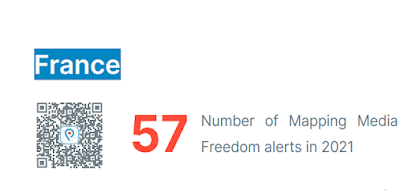Threats, following public appearances in the media.
In France, MapMF recorded 57 alerts in 2021, involving a total of 87 attacked persons or entities related to media. The situation has worsened against the backdrop of the start of the presidential campaign, despite the calming down of debates and protests over the Global Security Bill and National Policing Plan, which caused a high number of incidents in 2020 (see previous reports). With 27 alerts, harassment and psychological abuse towards journalists and media workers were the most frequent violations in 2021.
Fourteen physical assaults (24.6% were recorded on Mapping Media Freedom, seven of which resulted in injuries. One of the most violent and shocking physical attacks happened in February 2021 Christian Lantenois, photographer for the regional daily L’Union, was severely injured by a group of individuals who used his camera as a weapon as he was taking photos. The main suspect, a 21-year-old man, is being prosecuted for "attempted murder" and "failure to assist a person in danger." He has been remanded in custody pending trial.
While a majority of alerts concern journal‐ ists and editors (43, photographers, camera operators, or journalists holding cameras are increasingly targeted be‐ cause of the visibility that their equipment gives them. In March, a journalist for France 3 TV was violently assaulted as she was about to carry out an interview in a marketplace where a rally against health measures had been planned. While trying to hit the camera and intimidate the journalist, the person ended up injuring her face. In June, three media workers (a journalist, a cameraman, and a sound recorder), all working for daily news programme Quotidien, were physically assaulted by a celebrity while filming an interview. The cameraman was punched in the face and hit in the head, as the at‐ tacker was using the headset as a weapon in order to prevent the journalists from continuing the interview. In October, a TV crew for M6 was making a report on a drug trafficking case, filming in the streets in Normandy, when a group of fifteen people assaulted the journalists. The attackers started hitting the car in which the journalists found refuge with iron bars and stones. In Martinique, a TV crew for BFMTV, a photographer, and a photojournalist were filming when they were shot at three times in a row by two men on motorbikes. None of the journalists were hurt as they were able to get into their car and drive away. Nearly half of the attacks (27 alerts, 47.4% were perpetrated by private individuals while the number of alerts involving law enforcement authorities amounts to 10 17.5% they mainly concern coverage of events such as blocking access to events or protests, with police preventing journalists from covering the news. Sixteen cases occurred in the context of COVID-19, most of these during or related to demonstrations against COVID-19 measures and vaccination, where journalists were obstructed in their work, intimidated, threatened, insulted, verbally abused, or even physically attacked. The first tensions were observed at political rallies as the campaigns for the presidential election started in late November 2021. They exclusively concern rallies organised by former journalist and far-right candidate Eric Zemmour, whose supporters do not see the press in a good light.
Five cases document threats and attacks against journalists of foreign origin based in France. While it is difficult to confirm, it seems that most of these 5 attacks were coming from abroad. The most serious one involved Azerbaijani dissident and blogger, Mahammad Mirzali, who was stabbed 16 times by six people while walking down the street in Nantes. He was subsequently the victim of another series of threats, following public appearances in the media. He is reported to have left the country. Three more threats from abroad referred to the Pegasus scandal, named after the Israeli spyware which surveilled six French journalists from four different media outlets. According to Forbidden Stories’ revelations, Moroccan secret services had purchased the Israeli software to spy on the journalists. A few days later, Morocco filed several complaints against Forbidden Stories, Amnesty International, Le Monde, Mediapart, and Radio France for defamation. Disturbing threats were made to three female journalists Nadiya Lazzouni, Morgan Large, and Christine Kelly. Lazzouni received anonymous death threats via the post when a handwritten letter was sent to her home. Large found her car – parked near her house – sabotaged with two bolts removed from a wheel. Both requested police protection, which was eventu‐ ally refused. CNews TV presenter Christine Kelly was threatened with death several times during the month of November via emails and text messages containing reference to Eric Zemmour, a former colleague of hers. It is also worth mentioning that four media outlets were targeted in retaliation for their editorial policy: La Dépêche du Midi, a regional newspaper in Toulouse was the target of an arson attempt and the na‐ tional daily Le Monde lost an advertising campaign commissioned by oil giant Total worth €50,000 following an article revealing the company’s collusion with local military in Myanmar. Regional newspapers Le Dauphiné Libéré, l’Est Républicain, and Radio France Bleu Belfort Montbéliard also had their premises targeted and damaged by anti-vaccine demonstrators.



Comments
Post a Comment